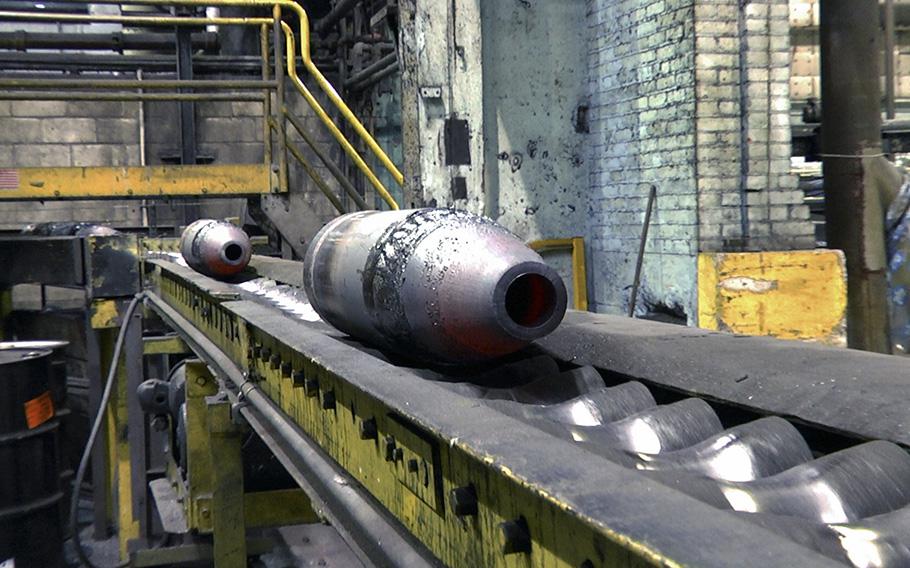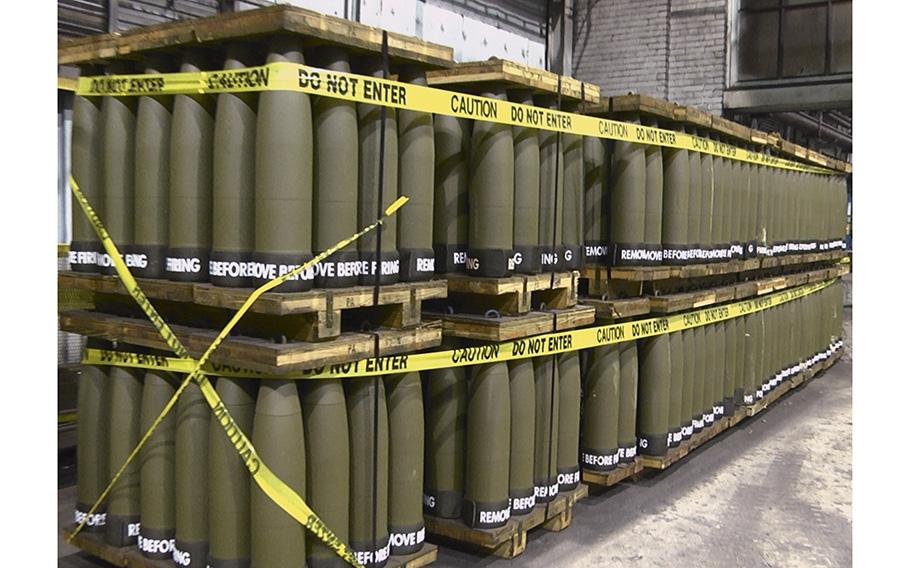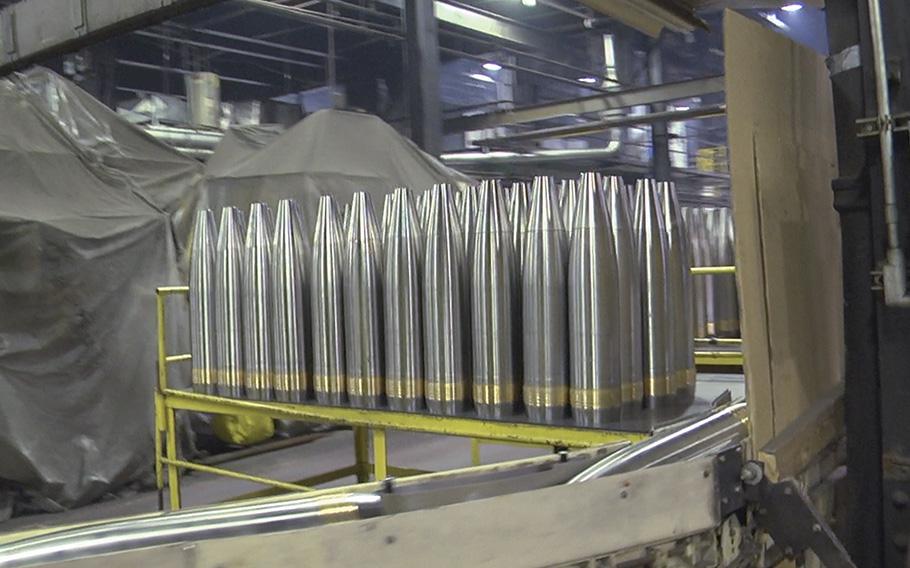
Scranton Army Ammunition Plant’s nosing process is depicted as ammunition parts move on a conveyor to the heat-treating process. Nosing is the process where the open end of the cylindrical parts are formed into the roundly tapered ogive. The parts are glowing red from prior heating before the forming process. (Dori Whipple/U.S. Army)
SCRANTON, Pa. (Tribune News Service) — The Scranton Army Ammunition Plant machinery rumbles, hums, sparks and sprays as it churns out a major weapon of war.
Just a short walk from Scranton's downtown, the plant produces more than 11,000 pressure-tested, thoroughly inspected, 155 millimeter shells a month, and its officials hope to eventually produce even more. About 300 people work at the plant.
On Wednesday, the U.S. Army showed off its capabilities. With the United States supplying Ukraine's defense against Russia's invasion, the need for the howitzer-fired 155mm keeps growing. The Army plans to spend $243 million over the next few years to modernize the plant and produce even more shells monthly.
Synchronized spray-paint guns coat the shiny, silvery steel shells in the Army's favored drab green. Each shell's structure is chemically altered to blow apart in nickel- and dime-sized pieces.
"Maybe quarter-sized," said Richard Hansen, a Navy veteran and the plant commander's official representative who led Wednesday's tour. "These are anti-personnel rounds."
In other words, they kill enemy soldiers.
War is never pretty, and the hulking U.S. Army plant's nine buildings aren't either.

Scranton Army Ammunition Plant manufactures large-caliber metal projectiles and mortar projectiles for the Joint Warfighter. (Dori Whipple/U.S. Army)
In four buildings totaling 495,000 square feet, Delaware, Lackawanna & Western Railroad workmen once produced and repaired locomotives during the first half of the 20th century. In 1951, the Army paid $2.2 million for it, and started military production. Now, its contracted operator, General Dynamics Ordnance and Tactical Systems, produces and stores shells here until their shipment to Iowa where robots safely install explosives amid thousands of empty acres.
"If we were to LAP (load, assemble and pack explosives) here, and we had a mishap, we'd probably take some of downtown with us and we don't want that," Hansen said.
The plant sells scrapped shells and trimmings to recyclers. It also collects rain for manufacturing processes — up to 62,000 gallons of water from an inch of rain, Hansen said.
As Navy veteran Hansen led the tour, Army Joint Munitions Command spokeswoman Justine Barati herded participants to the right places for the best views. Now and then, a human-operated forklift hauling massive boxes of metal scraps or headed for its next job rolled through.
"If you don't have a camera, step back so the cameras can get in," Barati said at one stop where space was tight.
The shells start as solid, long cylinders of steel, shipped to the plant 20 tons at a time on trucks, 200 tons per railroad car. An overhead crane with a magnet lugs them into position where a machine slices them into 14-inch, 115-pound bites.
A massive robot resembling a Transformers toy, its inner workings shielded by heat-resistant metal, lifts the bites into a furnace. The furnace softens the steel, turning it a bright orange, then the robot gathers each piece individually into other machines that stretch the molten metal to 30 inches and poke the holes that create tubes.
"That robot is working in 2,000-degree heat all day long," Hansen said.

Scranton Army Ammunition Plant manufactures large-caliber metal projectiles and mortar projectiles for the Joint Warfighter. (Dori Whipple/U.S. Army)
Conveyors move the pieces to a machine that shapes a shell end to a smoothed nose, then another that threads inside the nose so a fuse can be screwed in once explosives are inside. Another machine ultrasonically tests for defects. Still another threads the bottom of the outer shell so the howitzer mechanism can efficiently grab it before firing.
Inspectors check each step. Painted red "X's" dot shells that fail quality tests. Sky blue and orange paint means a shell moves on to the next step. No shell heads for Iowa until the Letterkenny Army Depot in Franklin County tests a representative sample of each batch, Hansen said.
A second furnace along the way heats each shell to more than 1,500 degrees to refine its deadly composition and add "the ability to do what it's designed to do," Hansen said.
"It's freeing up the mechanical properties in that steel, so that when we go to quench at the other end, we're kind of freeze-drying those mechanical properties in place," he said. "The only goal that we have here at the end of the day is ensuring that when this thing is fired, it does what it's supposed to do."
(c)2023 The Citizens' Voice (Wilkes-Barre, Pa.)
Visit The Citizens' Voice at citizensvoice.com
Distributed by Tribune Content Agency, LLC.